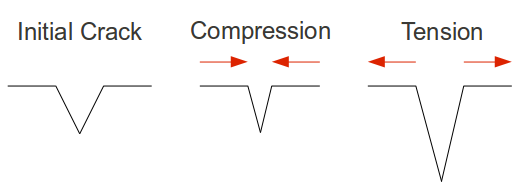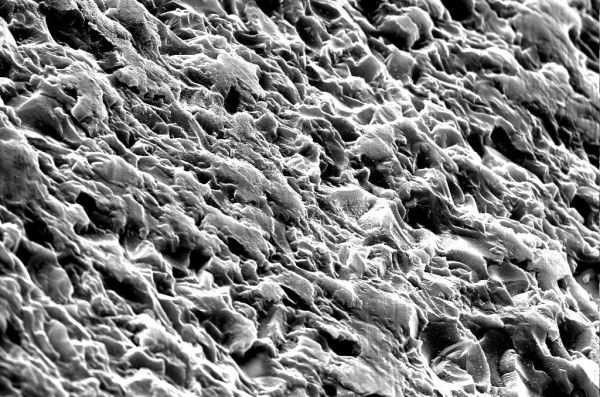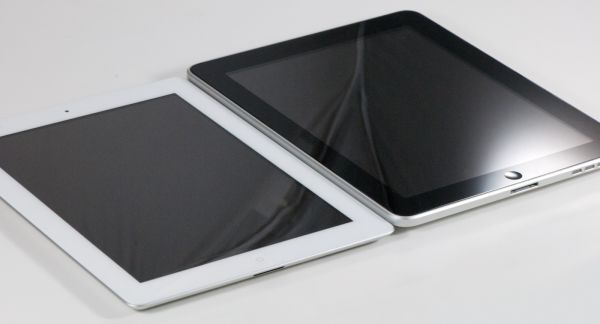The Apple iPad 2 Review
by Brian Klug, Anand Lal Shimpi & Vivek Gowri on March 19, 2011 8:01 PM ESTI asked a friend of mine, Alexander Miles, to write a bit about the properties of glass that really contribute to its overall strength after reading that the iPad 2's glass is 0.62 mm thick compared to 0.85 mm thick in the iPad 1. Hopefully this dispels some myths about glass strength and clarifies. Alex is a senior double majoring in Materials Science and Engineering and Optical Science and Engineering at the University of Arizona.
On the Strength of Glass
We usually think of things failing under compressive stress, being pushed inward from both sides until it they are crushed. Glass and ceramics, it turns out, are incredibly strong in compressive stress. Strictly by the numbers, a fire truck could be supported by a ceramic coffee cup underneath each tire, but only if the load was perfectly downward. Why then are glasses so fragile? This is because no situation causes only compressive stresses, and tensile stress (imagine pulling something from both ends) is what causes glasses to fail. One can think of tiny cracks inside the glass being pushed closed under compressive stress, but torn open under tensile stress.

A schematic illustration of crack behavior in brittle materials.
If you test the tensile strength of thousands of pieces of glass with identical processing and geometry, you will get thousands of different answers. This is markedly different from metals, where you will get nearly the same result every time. The reason being that glass and ceramic materials have a much lower fracture toughness, as much as 100 times smaller than that of a metal. Fracture toughness indicates how easily a crack can propagate, or to phrase it differently, how big a flaw will cause fracture for a given load. As the required load for normal flaw sizes in metals is enormous, metals typically do not fracture in the way glasses do. Metals usually fail in what is called plastic deformation, necking down then tearing away, long before fracture can occur. This plastic deformation is very predictable and follows the stress-strain curve for the given metal, whereas glasses are less predictable.
The question now is, how does the size of a piece of glass affect its behavior under tensile stress? It depends on the distribution of flaws within the material. If you strike a piece of glass with a hammer, a compressive stress is created right below the hammer, but a ring of tensile stress is also created around the spot you hit. You are essentially sampling the distribution of flaws, because if any of the flaws in the affected glass are big enough to widen with the stress you provided, they will rapidly propagate and the material will fracture. The stress field extends down into he material, so flaws in the volume can cause failure as well, though surface flaws are more consistently to blame as the stresses encountered there are almost always larger.

SEM image of a broken glass surface, (CC BY-NC-ND 2.0) attribution St Stev's flickr.
In glasses the distribution of failure stresses is described using Weibull statistics, giving a peak where most samples fail, and tails both on the high and low end where samples had abnormally high and low failure stresses respectively. The long and short of this is that consistently processed samples will have a more narrow distribution as the geometries are scaled down. This means that a thinner piece of glass will have fewer flaws in the bulk and far less likelihood of having a large enough flaw to cause catastrophic failure compared to a thicker piece of glass. The fact that the screens have a large aspect ratio, that is they are far thinner than they are wide or long, means that the effective stiffness will be different in the two directions. Taking this to an extreme, a very thin glass fiber is fairly flexible in bending, but very stiff axially, as its cross-section is so small that very few flaws are contained inside it. If one needs to break a glass fiber, a surface flaw is usually created by scratching it first.
| Approximate values for the strength of common soda lime glass in various conditions | |||||
| Condition | Tensile Strength (MPa) | ||||
| Theoretical Maximum (Flawless) | 9810 | ||||
| 3 Micron Fibers | 3330 | ||||
| Thin rods, fire-polished and acid etched | 3420 | ||||
| Thin rods, no special treatment | 690 | ||||
| Bulk, ion exchange tempered | 350 | ||||
| Bulk, thermally tempered | 300 | ||||
| Bulk, fire-polished and acid etched | 220 | ||||
| Bulk, no special treatment | 50 | ||||
In order to use glass screens on our devices, we would like it to be far tougher, where "tougher'' ideally means both more resistant to fracture as well as more resistant to scratching. There are two basic schemes used to strengthen glass: elimination of the surface flaws, and creation of compressive stress in the bulk of the glass. Eliminating the surface flaws by polishing, fire-polishing (heating them until surface tension flattens out the flaws), and acid-etching does indeed increase the strength, and drastically so. An increase in strength of up to one hundred times can result from such treatment, but is temporary as microscopic scratches from handling will quickly reduce the strength back to what it was before.
The second scheme for improving strength, introducing a compressive layer, works because existing compressive stress in the glass has to be overcome by the induced tensile stress before any cracks can propagate. To say it plainly, if you don't hit it hard enough with a hammer, it will not even see the type of stress that makes it fail. The down side to this method is that every force causes an equal and opposite force, meaning that a lot of compression at the surface causes tension at the center. As long as a crack does not reach the volume with the additional tensile stress imposed on it, the glass will hold together, but once it does it releases the energy kinetically and fails catastrophically (it explodes like a pumpkin with an M80 stuffed in it).
The way this layer is created varies based on the application. For car windshields, they are thermally tempered by chilling the outer surface while the center is still hot, as the surface remains solid while the center is still busy shrinking, which leaves the surface in compression. Similarly, coating the glass object in a second type of glass with a lower thermal expansion will cause the same effect, as the outer surface shrinks the center is shrinking faster. The multiple-glass approach has the additional benefit that cracks have difficultly moving from one type of glass to the next, leading Corning to produce some glasses with as many as 7 layers.
The final method, and most relevant to our discussion, is ion-exchange. Ion-exchange refers to removing small ions, like sodium, from the glass, and replacing them with larger ions like potassium, all at a temperature that prevents the structure of the glass from adjusting itself to these new bigger ions. The way this swap is actually done is by immersing the glass in a molten salt solution containing the ion we want to substitute in, and allowing it to diffuse in over time, while the smaller, more mobile, ion diffuses out. Depending upon the type of glass, the ions being exchanged, and the desired depth, this process can take as long as several days.
The iPad 2 and previous iPad both utilize Corning Gorilla Glass. This type of glass is an alkali-aluminosilicate, being primarily silica and aluminum with an alkali metal, along with other unspecified components mixed in to tweak its properties. The biggest benefit of alluminosilicate glasses, aside from being relatively tough to start with, is the fact that the rate of ion exchange is fairly high even at temperatures low enough that the structure cannot react, meaning it can be processed quickly and create deep protective layers in the glass. The iPad 2 has a modest reduction in the thickness of the glass (about 23% thinner, for those interested) compared to the first iPad, and the question of increased fracture risk has been posed. Given the identical surface quality between the two generations, the reduction of thickness should create no palpable change in toughness for the typical user. That is to say, a drop that would shatter the screen on the original iPad would likely do the same for the new model. That being said, several other design changes appear to account for the change, and might yield better performance in this department.
Where its predecessor used small metal clips to retain the glass screen, the current iteration uses a ring of adhesive around the entire perimeter that not only distributes the load around the glass and prevents scoring at the glass-metal interface, but better couples the stresses into the more compliant aluminum frame. Both of these measures should improve the performance; either way, drop-testing new electronics is generally not recommended.











189 Comments
View All Comments
Mishera - Wednesday, March 23, 2011 - link
An and you made an excellent point when you said that tablets don't seem on a path towards perfection. Right now IPads are somewhat of a novelty. They're kind of like that thing you see at a museum as a child that make you go "wow" or a concept at a convention that's not fully realized. The problem is people seem content with the device as it is because it's Apple, and companies are trying the "square in circle" method to put it in schools, businesses, etc.Thats what really bothers me. Apple pretty much marches on it's own beat, consumers eat up what they release, and companies desperately try to run behind them and release something with better specs, never questioning if there is a better direction. As a consumer device it's excellent, its just there are so many more directions tablets can go. I would almost would say that Microsoft had a better idea of what a tablet should be with their umpc line, except they could never get the ui right, and now it seems like their hardware endeavors are over for so I wonder who could really bring a better concept to market. To make tablets work it's going to take on os and a hardware so far android can't do it, microsoft won't to it and hp is still a question mark so we just have to be content with whatever apple gives us.
Zink - Sunday, March 27, 2011 - link
Here's a very surprising video showing the flexibility of the glass used in the screen.http://www.youtube.com/watch?feature=player_embedd...
JustinB - Monday, March 28, 2011 - link
While OEMs are racing to create a competitor to the iPad, it seems like commenters on sites like this are trying to create a competitor to the Reality Distortion Field...NetJunky - Tuesday, April 19, 2011 - link
Actually Dropbox has its own lack of security. So I wouldn't say, that this is a best example of data sharing via web.Bronx 6 - Tuesday, June 28, 2011 - link
Apple had touch first congrats.They can keep there not so tech ridiculously rich ppl who buy lesser powerful or frivolous shoppers.xoom is to much with not enough (like ipad) on board no dongle needed ports/hdmi/usb/micro usb like acer.i bought an ipad2 as my first owned apple product just so I could show everyone whata piece crap it is and then return it to the store.The things I get off android apps are sooooooo much better because they arent being ran by the Nazi's (apple).,i like not having to waste money on anything app wise,movie(better than anything I could dream for) and of course free absolutely FREE music mp3s.now I even get artwork on them and they appear just as if I bought them.The music mp3 apps even (some) even include music charts so you know what's new and hot.i dont need cable tv,satelite,nadda I get thousands of channels free from apps which use flash and lemme tell flash is the key to the future and present.i love how developers make the good apps ipad has for honeycomb tabs(splashtop hd remote desktop)-myfav allows me to use all pcs as if I was on it even whem im in another state.the resolution is amazing also the many keyboards u can get-new swype is surreal should be stock on all tabs.tried to ruin acertab with viruses it wont phase it amazing alone.i so love the apps on droid they are made by ppl wno arent like the government and honeycomb keeps getting better asnow 3.1 is so muchbetter and its free.the power.of these tabs are like two ipads and the cameras on ipad2 is patheic like an old boostmobile vga cam.mine has the same quality cameras as iphone4 has another + acer has the best tab for the buck they have a functual full usb port and it connects alot.of useful things like keyboard,flashdrives,ch arging capabilites.i had bought one accessery a case stand that's it had hdmi cords already.the ipad I bought over 8 seperate things totally a money hungry company who designs product too keep you buying shit week after week.itunes is just plain retarded.i get the sameshit they do for free easier than a pc.wide open is free like usa is supposedly.if ur reading this and have a tablet download swype beta for honeycomb.It takes the basic stock keyboard but adds stuff u will love even if you dont swype u type better than the stock more like a real one.i bought 2apps in 2YRS yet ive had more than I can think of.i spent $8 total.i have sold more of these to anyone I show and teach.my old mother has one and now wont use her win7 pc's only thru the tablet-thats including me fixing her old pcs accross the country in california all from my badass acer tablet.apple should stick to ipods.droid tabs are diffently ipad.killers.i hope ppl enjoy wasting their money basically getting raped.so dumb ppl stay apple,smart ppl sick of paying for things that we shouldnt and having the ability to do all n then some on tablets enjoy.ps these flash modified apps on droids I cant praise the quality they look during playback is wow.ive watched more hdtv thru this than I have in years with my hdtv sets pretty crazy,so is the gaming similar to xbox360.buy an galaxy tab first then return it for an acer so you can appreciate getting more for less.send me the difference for enlighting u on values of better things.then again the world is more than 50% ignorant and very rude to ones who help them.take it as grain of saltrampantarmadillo - Thursday, August 18, 2011 - link
I recommend that you learn to seperate vertex and fragment perf, this would demonstrate you aren't clowns.powchie - Saturday, December 10, 2011 - link
anand, brian,what's that workflow that the iPad cannot fit in?
ChaoticCupcake - Tuesday, December 27, 2011 - link
Any word on whether or not a camera can be attached and used as a webcam for FaceTime, Skype, etc.?omkarphatak - Tuesday, February 28, 2012 - link
Find out why choosing an iPad 2 over a laptop makes no sense... http://www.buzzle.com/articles/which-is-better-ipa...